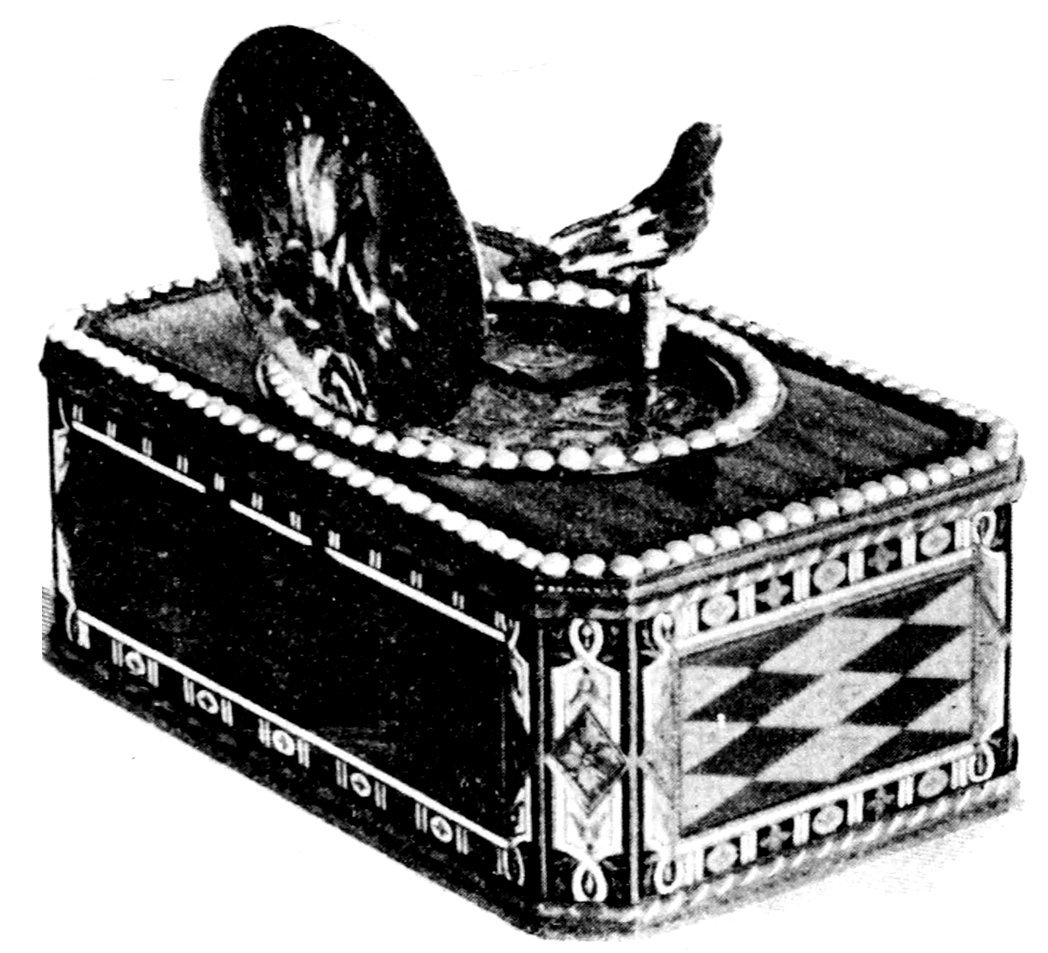
Singing Bird Box
Signed “Jaquet-Droz and Leschot London”
(from an old engraving)
Actually in the collection of Mr Luis Dubois-Favre
Le Loele, Switzerland.
Transcriber’s Note:
The cover image was created by the transcriber and is placed in the public domain.
The invention of these marvellous pieces of mechanism dates from about the middle of the eighteenth century.
When they first appeared they were so highly praised that they were immediately bought by the principal Courts of Europe, and it is only later, at the beginning of the nineteenth century, that the very high class of people could acquire the rare specimen that came now and then on the market.—
The characteristic of the antique singing bird snuff boxes, is that the bird, when singing and moving its wings, opens its beak, when turning the head. It is unfortunate to say, that modern watchmakers have not acquired the skilfulness of their predecessors, and that in modern boxes this triple movement can no more be obtained. This is, as a matter of fact, one of the first means of distinguishing an antique bird box, from a modern one.—

Singing Bird Box
Signed “Jaquet-Droz and Leschot London”
(from an old engraving)
Actually in the collection of Mr Luis Dubois-Favre
Le Loele, Switzerland.
The discovery of these small curious pieces of mechanism is due to a Swiss watchmaker whose name is
This wonderful artist was born at La Chaux de Fonds (Switzerland) on the 28th of July 1721. His parents, rich peasants, seeing the great dispositions of their Child for Study, had projected to make a clergyman of him, and consequently sent him to study theology at Neuchâtel.
During his holidays, which he used to spend at one of his sisters, who, having abandoned the old industry of this city, which was lacemaking, married a watchmaker, the young Peter was deeply interested in all mechanics, and spent all his time working at his sister’s workshop. He soon became so industrious that everybody induced him to leave Theology and become a watchmaker.
His improvement astonished even the oldest and very best workmen, and he soon became their master.
It was about the year 1752, the year of his marriage, that he made his first singing bird,—in a gold snuff box, the bird appearing and singing when opening the box to take snuff.—
His fame became so universal, that in 1758 he was summoned by the King of Spain, for whom he worked, and made such marvellous automata that the Santa Inquisition, at a certain time wanted to condemn him as a “Sorcier,” a very terrible charge at that time.
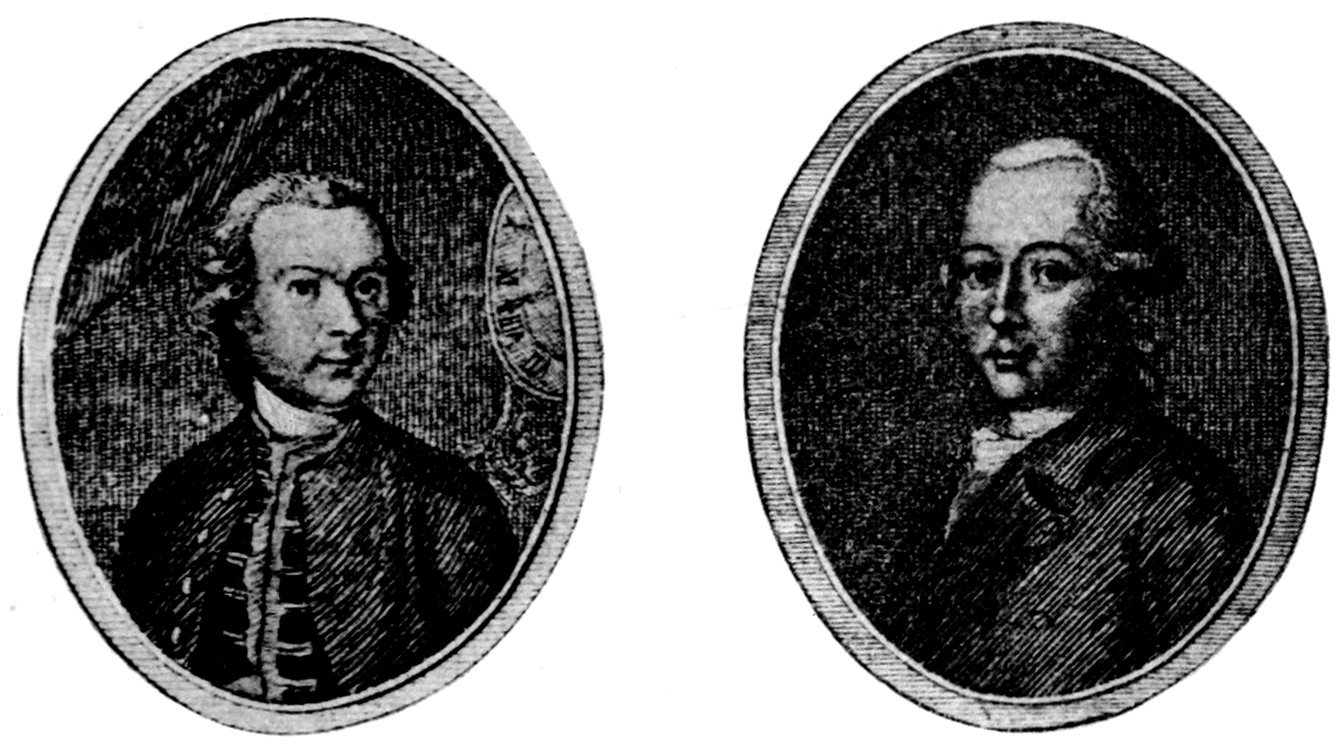
Pierre Jaquet-Droz Henri Louis Jaquet-Droz
From a design by Girardet (1795)
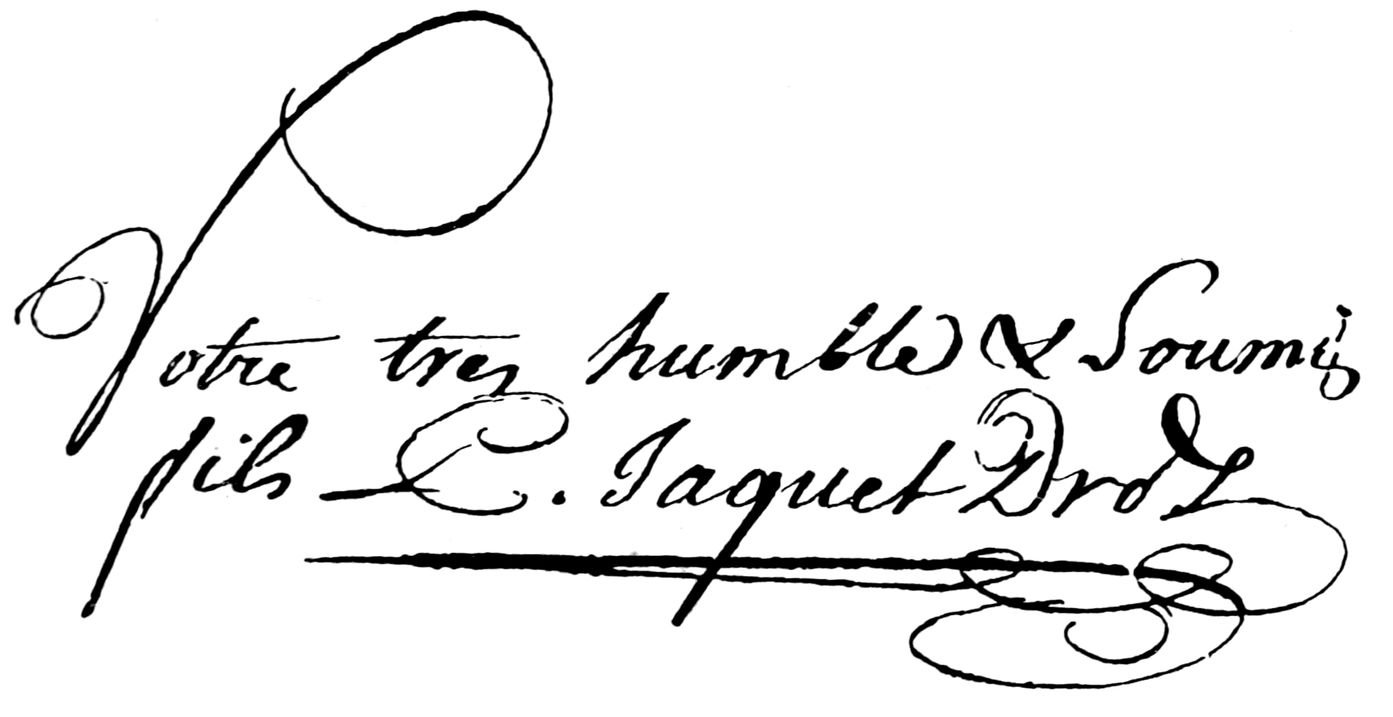
Signature of Pierre Jaquet-Droz
The King of Spain having died soon afterwards, he returned to La Chaux de Fonds in 1759. In 1767 he sent his son Henri Louis Jaquet-Droz to France, where he studied mathematics in the University of Nancy (Lorraine) and on his return, three years later, he took him into partnership with him.—
The productions of the father and the son then attained the utmost of perfection. In collaboration with his father and of the very best workmen of that time, Leschot, Maillardet, and Jean Pierre Droz (who became Director of the Paris Mint) Henry Louis Jaquet-Droz, made the most marvellous pieces that have ever been produced;—the Designer, the Clavecin Player, the Young Writer, wonderful specimens which still can be seen in perfect condition and still working in the Museum of Neuchâtel.
In 1774, Henry Louis Jaquet-Droz came to Paris and was received with the greatest favor by King Louis XVIth and especially by the young Queen Marie Antoinette, who had ascended to the Throne the same year, who was particularly and deeply interested in his Works after she had seen the “Designer” by pressing a button, making her own portrait and that of the King’s on a blank sheet of paper placed before the instrument.—(This can still be seen in Neuchâtel every month, and also at any time by payment of a fee.)
Jaquet-Droz afterwards went to England, where he was received by King George III.
It is in England that he made most of the singing bird boxes known of his construction.
He started a workshop in London where the most important and interesting pieces in complicated watches and boxes were made,—which after were to be found in almost every part of the world, even in China, as in 1860 on the occasion of the pillage of the Summer Palace of the Emperor of China, many pieces signed by Jaquet-Droz were discovered and brought back to Europe.
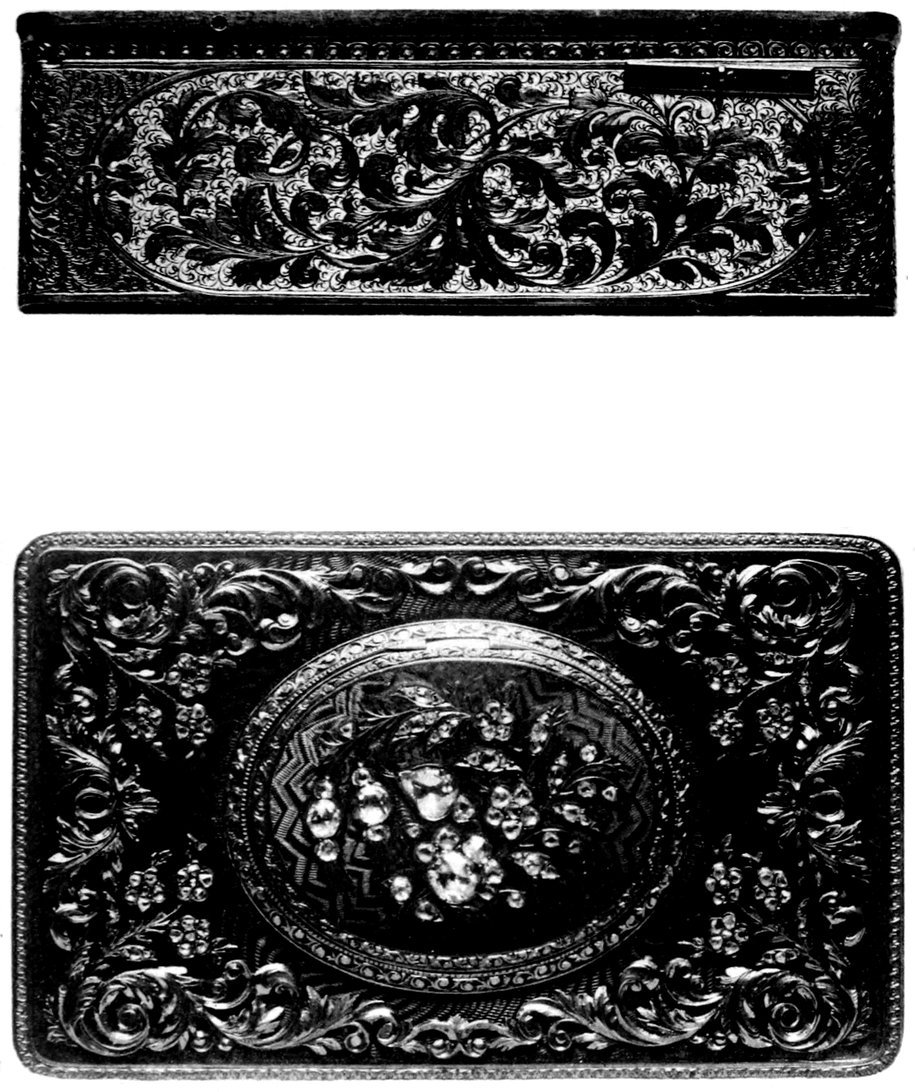
Gold, enamel and diamond Bird Box by “Bruguier—the Father”
Collection Tiffany & Co., New York
Every one is aware how much works of this nature are appreciated by the Chinese in general, and the fact that several of Jaquet-Droz’s productions were in possession of the Emperor of China is a sufficient proof of the genius of this artisan.—
Peter Jaquet-Droz died on the 28th November 1790 aged 69 years.—
His son Henri Louis Jaquet-Droz whose health had always been delicate died in Naples, where he had gone for a cure, on the 15th November 1791 aged 39 years.—
Little is known of the life and history of other manufacturers of Singing Bird boxes, as they were artisans in a very small way of business, working quite by themselves, in villages surrounding Geneva.—
The following is all we could find about them.——
Charles Bruguier, is better known under the name of Bruguier le Père (Bruguier the Father), was born in about 1750 and died in 1830. He had two sons: 1º Jacques Bruguier whose date of birth and death are unknown, and 2º Charles Bruguier known as Charles Abraham Bruguier or “Bruguier-the-Son” born in 1788 and dead in 1862, leaving his brother and his son who died in 1886, thus ending this family.
The three Bruguiers made very elaborate and fine bird boxes which they marked with their full name, and a number indicating date of same.
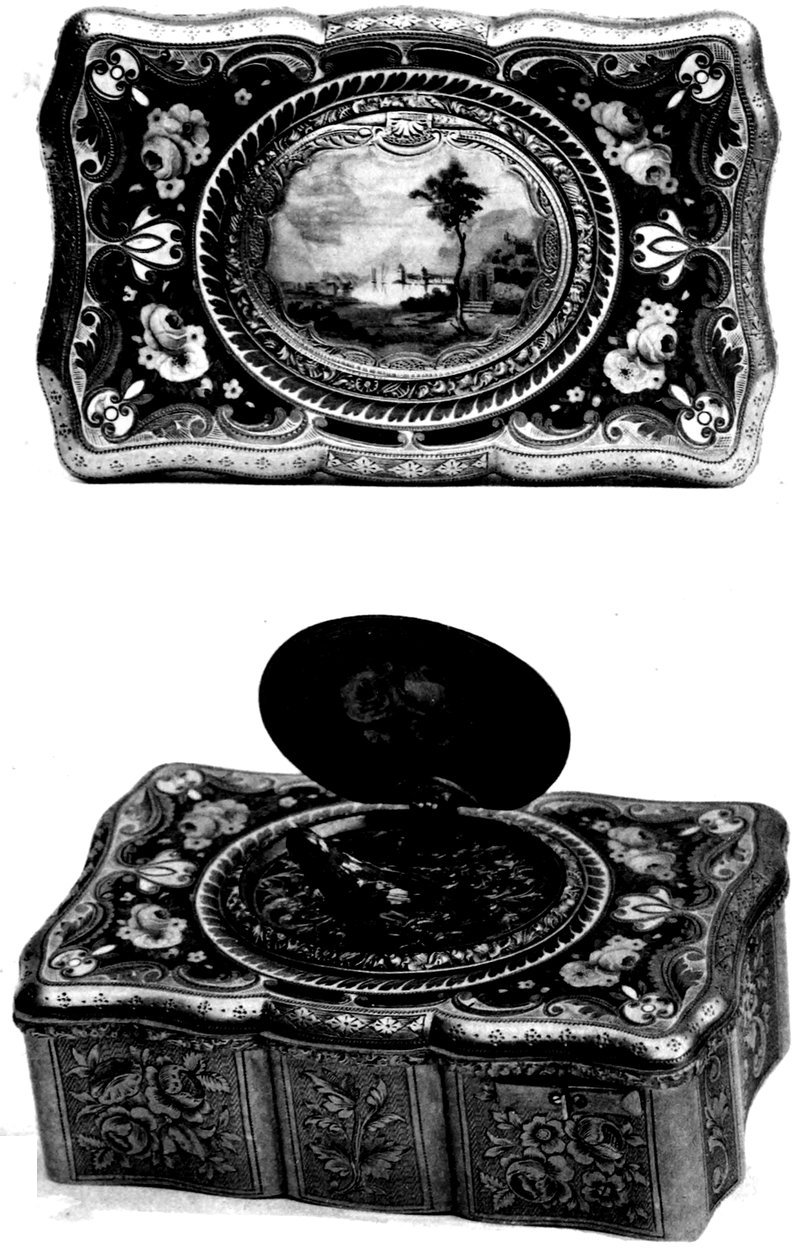
Silver gilt and enamel Bird Box signed “Charles Bruguier, Rue des Pâquis 5, Genève”
(Charles Bruguier-the-Son’s own handwriting)
Collection Tiffany & Co., New York
This artist lived about at the same time as Bruguier the Father, that is from about 1750 to 1827, but the exact dates of his birth and death are uncertain.
The pieces of Bruguier du Grand Pré, are generally smaller than those of Bruguier the Father—and are considered by connoisseurs as superior. He lived in the surroundings of Geneva, and marked his pieces with his mark and a number indicating the date of manufacture.
Pierre Rochat was born in the year 1780, he lived with his two sons Ami Napoléon Rochat and Louis Rochat, at a place called “Chez Meillau” au Brassus, Valley of the Lake of Joux, Switzerland. He devoted himself with his sons to the manufacture of Geneva music boxes and other small pieces of the same kind,—most of them hidden in various small objects, such as snuff boxes, bonbon boxes etc.
After having lost his fortune in building speculations, the Rochat family came to Geneva in 1815 and prospered again by making most curious marvels of small mechanics, which were highly appreciated by the connoisseurs and sold to the principal courts of Europe.—
Pierre Rochat had been for some time in the employ of Jaquet-Droz.—
Ami Napoléon Rochat the eldest son, made a speciality of the singing bird boxes which established the reputation of the name of Rochat all over the world.—
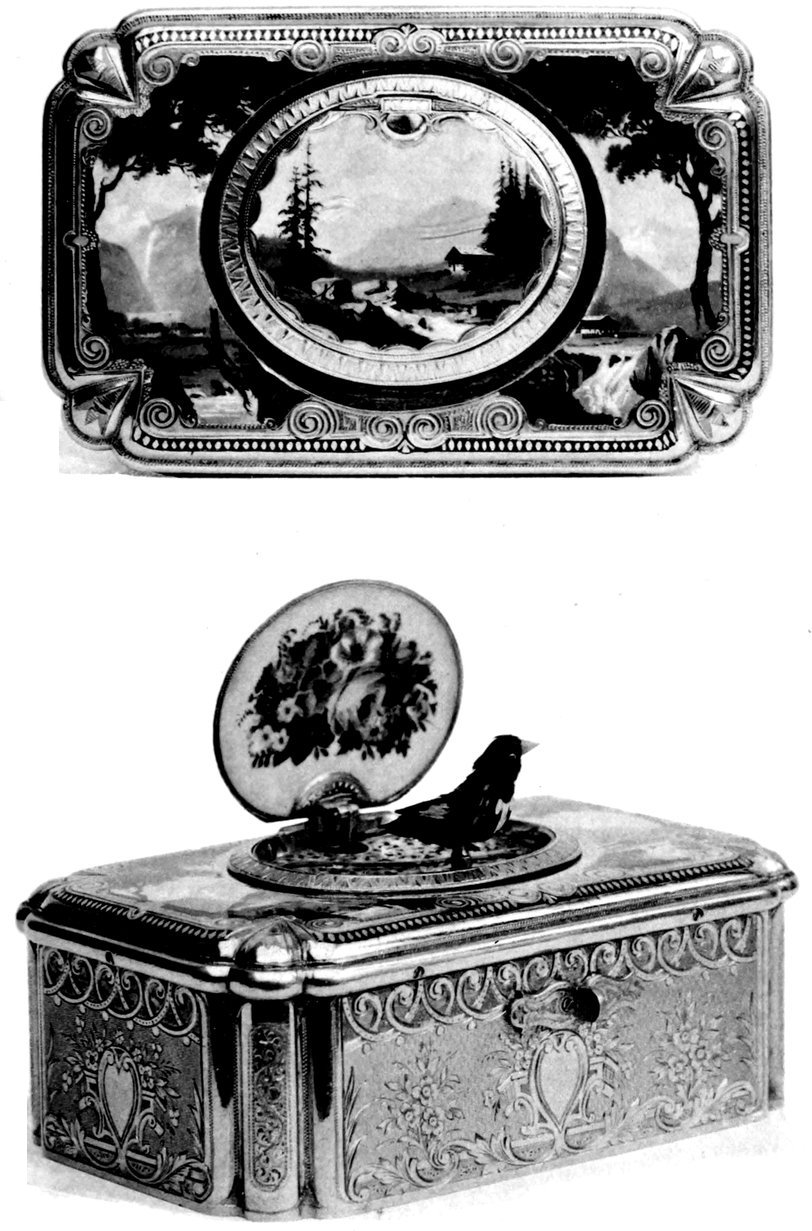
Silver gilt and enamel singing Bird Box by Charles Bruguier
Collection Tiffany & Co., New York
The work was absolutely perfect, especially the singing and extreme complication and smallness of the mechanism the bird opening its beak and turning its head when singing.
Louis Rochat the second son was in that line even better than his brother; he conceived and executed the most curious and complicated pieces, which have never been imitated since; for instance singing bird watches and the famous Singing bird Pistols, where a bird appeared and sang out of the barrel when pressing the trigger. A very rare specimen of such pistol is in the Bernard Frank collection in Paris, one of the most renowned collections in Paris.—
In 1829 Louis Rochat made a curious and complicated clock, for which he was awarded by a special diploma, and appointed “Companion of the Watchmakers and scientists of the city of Geneva.”—
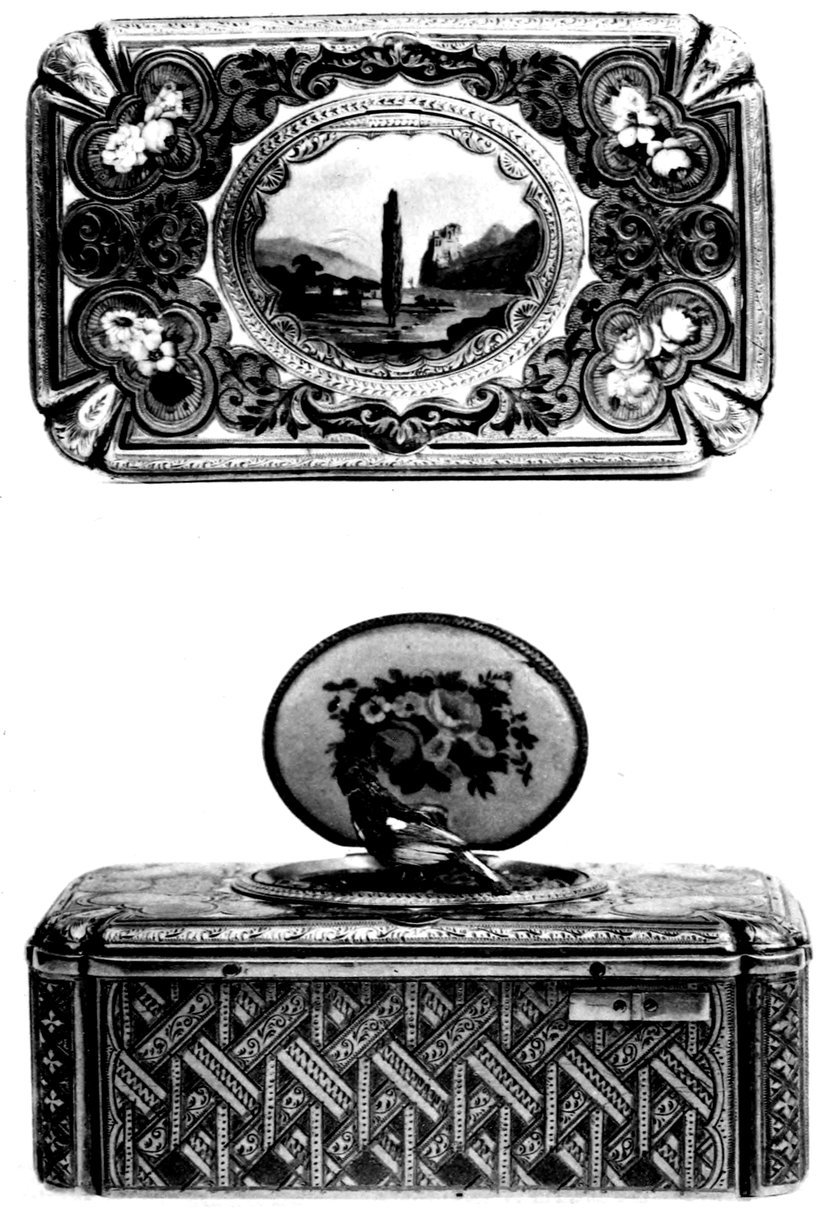
Silver gilt and enamel Bird Box by Charles Bruguier-the-Son
Collection Tiffany & Co., New York
This artist was born in 1810 and died in 1902.
He made singing bird boxes of the same size and grade of work as the Bruguiers.
They are just as well quoted by connoisseurs as these, but they are very difficult to recognize as he did not mark nor number them.—
To these different names it is only right that we should add that of the Maillardet Family:
Jean David Maillardet and Auguste Maillardet who have made many small mechanical works, after their collaboration with the Jaquet-Droz.
Unfortunately they very seldom signed their pieces, and the documents respecting their biography are consequently inexistent.
Some of their works have anyhow come under our notice, for instance a snuff box which belongs to a private collection of Neuchâtel and is loaned to the Museum of La Chaux de Fonds. The origin of that piece has been traced as it has been won in a lottery, the curious advertisement concerning which (dated 27 March 1847) is still to be seen in the Museum of La Chaux de Fonds. The number of tickets issued for the lottery was 2700, each of which was valued at “3 Francs of France.” This snuff box, bearing No 5, was valued at the time at 420 “Francs of France” (what should its value be now)?
The second piece is a “Magician” executing all sorts of tricks, which is still exhibited in the Museum of La Chaux de Fonds.
